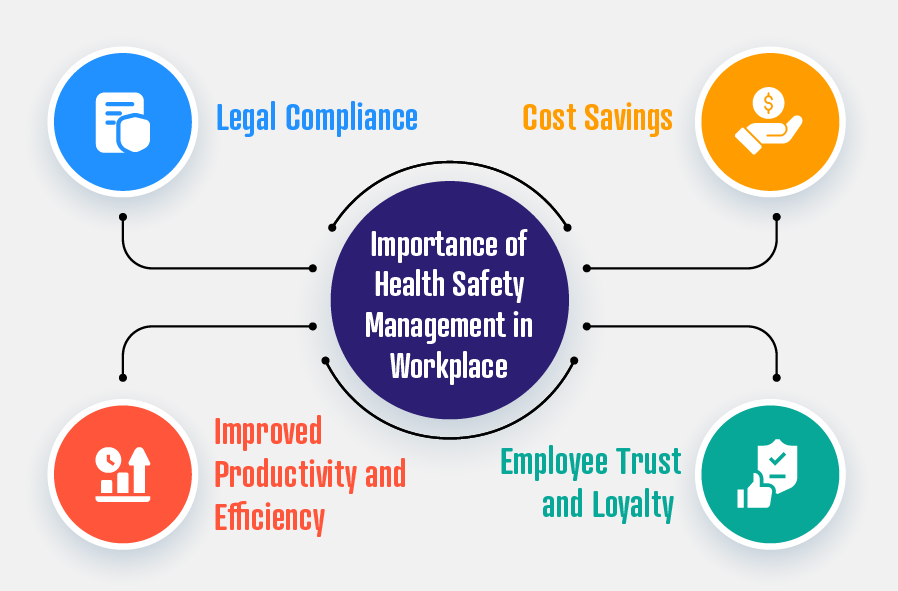Be it a small startup or a large enterprise, successful organizations know that their employees are their biggest assets. It is their skill, hard work, and capabilities that helps the business grow and compete in the market. Safe to say, employee safety and welfare has to be at the forefront of critical business decisions.
This means taking the necessary steps to prevent workplace illness, accidents, and injuries to ensure a productive and healthy workforce. Health and safety management then becomes an integral part of creating a safe workplace environment for the employees.
In any workplace, health and safety management involves a systematic approach to identifying, assessing, and mitigating risks within the workplace. Its primary objective is to establish and enforce protocols that prioritize the safety of employees. This framework is essential for regulatory compliance, to ensure a safe working environment, and minimize the occurrence of accidents and injuries.
In this article, we explore the role and importance of health safety management and relevant systems in reducing workplace accidents and injuries.
The Role of Workplace Health and Safety Management
Health and safety management in a workplace refers to a set of practices and procedures implemented to ensure the physical and mental wellness of employees while on the job. This program, with the help of safety management system software, helps businesses identify hazards and take the necessary steps to prevent workplace injuries and accidents.
Creating a safe and secure work environment is more than just a legal requirement; it is the moral duty of employers, as workplace injuries not only affect employees' health but also cost the business in terms of time and resources. Here's why health and safety management is crucial in a workplace

Legal Compliance
Workplace health safety management is a critical aspect of regulatory compliance. By aligning workplace safety protocols with industry regulations and legal requirements, companies not only prioritize employee health but also protect the organization from potential legal consequences and financial liabilities.
Cost Saving
Workplace accidents and injuries cost the organizations in terms of medical expenses and compensations for the employees, as well as the loss of work and resources due to the injury. With effective health and safety management systems in place, businesses can save on these unfortunate costs.
Employee Trust and Loyalty
A strong commitment to workplace health and safety shows an organization's dedication to protecting its employees. This helps foster a culture of trust and loyalty among employees, customers, and stakeholders and increases the business's reputation.
Improved Productivity and Efficiency
With effective health and safety management, businesses can help their employees feel secure and supported at work. This boosts employee morale and enhances workplace productivity and efficiency.
Important Functions of Health and Safety Management
Robust health safety management in an organization to reduce workplace accidents involves the following-
1. Identifying Potential Hazards
A fundamental aspect of HSM is the continuous assessment of potential hazards in the workplace. This involves identifying risks associated with tasks, equipment, or the working environment, possibly with the help of health and safety management software. Once identified, health and safety management involves the development and implementation of strategies to mitigate these risks effectively.
For instance, a company may detect a risk of flood in the warehouse and address this risk by building a safety wall and water drainage system within the surrounding areas. So, by proactively addressing potential hazards, HSM plays a critical role in preventing accidents and injuries.
2. Developing Safety Policies and Procedures
Another key function of health safety management is to establish clear policies and procedures that promote safe work practices and reduce the risk of workplace injuries. This includes defining the emergency procedures, developing procedures for the proper use of tools and equipment, and promoting the safe handling of hazardous material.
Health and safety management must also ensure the effective implementation of these policies by communicating them to all employees. Most of all, these policies must be reviewed and updated regularly to stay relevant and valuable for the organization.
3. Ensuring Availability of Resources for Implementation
Health and safety management also plays a crucial role in ensuring the availability of appropriate resources to support the implementation of safety programs. This involves providing protective equipment, ensuring the availability of first aid kits and timely treatment, and offering training and education to ensure continuous improvement in workplace safety standards.
4. Evaluating the Effectiveness of Safety Programs
The effectiveness of safety programs can only be measured with continuous monitoring and evaluation. Health safety management must include regular audits and inspections to ensure consistent implementation and identify areas for improvement. By staying on top of their safety measures and protocols, organizations can lower the chances of injuries substantially and promote a healthy work environment.
5. Training and Education
Finally, employee training and education form the backbone of successful health and safety management. To promote a safer work environment, there must be regular training programs to offer the necessary skills and knowledge to employees to build a safe workplace. This involves providing information on health and safety matters, proper use of equipment, adherence to safety protocols, and responding to emergencies.
With proper training and awareness, health and safety management creates a culture of safety within the organization.
Ensure Workplace Safety with Effivity
When it comes to the health and safety of your employees, you cannot take any chances. It is a critical aspect of building an efficient, productive, and safe business environment. But manual processes can be labor and time-intensive, complicating health safety management.
But it doesn't have to be that way. If you're looking to implement robust health and safety management, consider opting for Effivity's software for safety management system.
With Effivity's health and safety management software , ensure compliance with ISO 45001:2018 requirements, reduce risk, and promote a healthy workplace for your employees. Our OHSMS is workflow-driven, which ensures compliance management across the organization. With a scalable, cost-effective, and automated platform, you can enhance your workplace safety procedures with ease.
Visit our website and schedule a demo today!






























